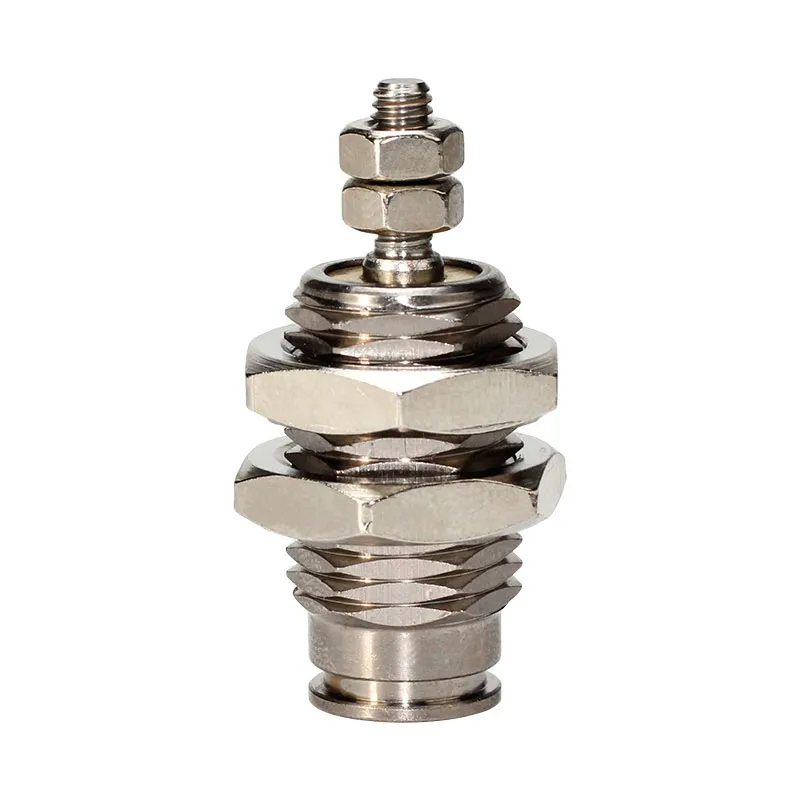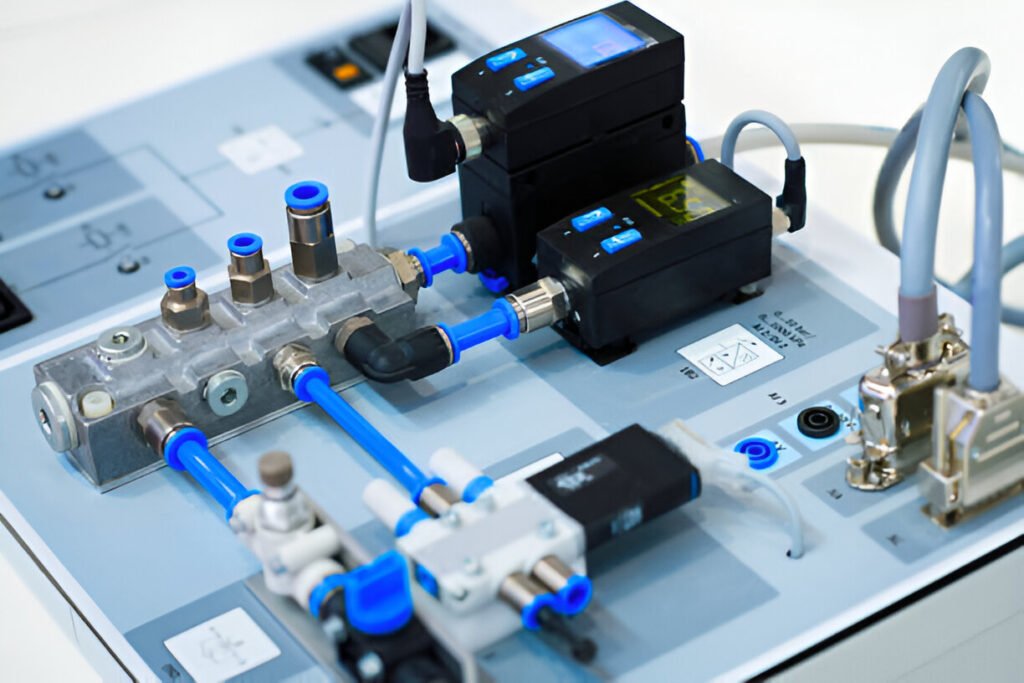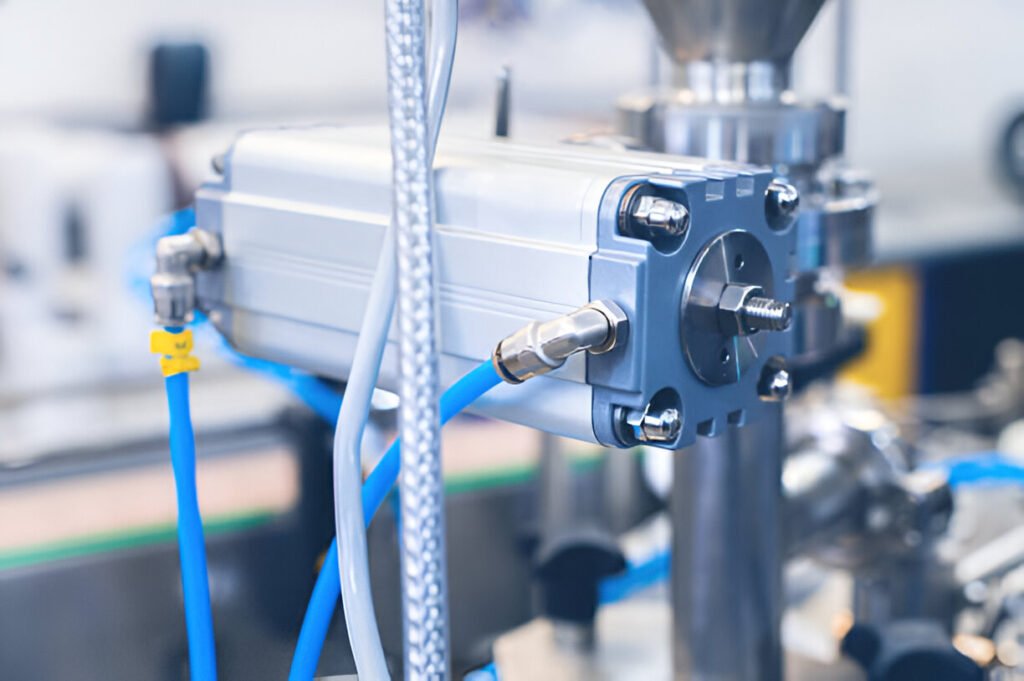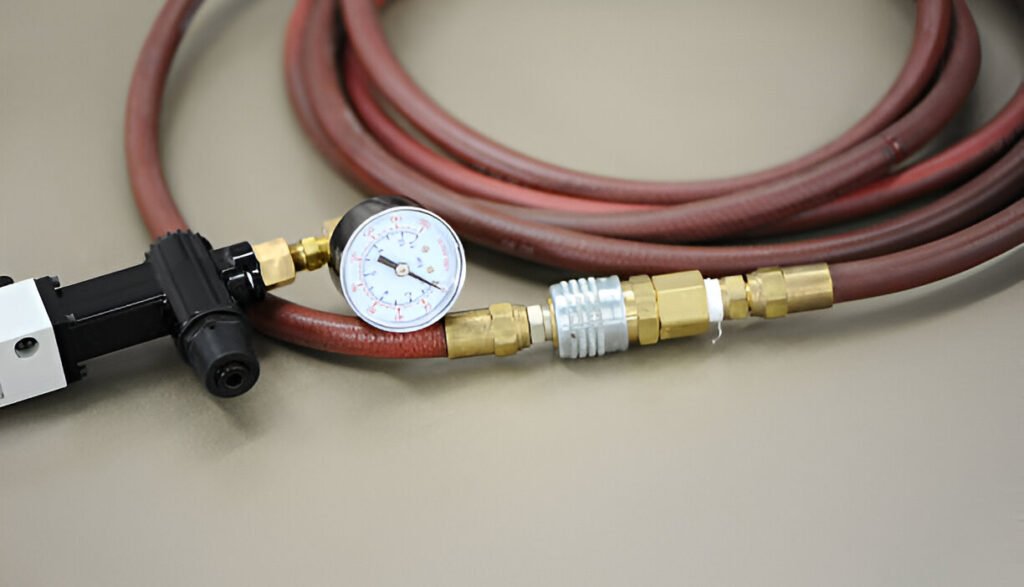Briefly describe the application background of mini cylinders
Mini cylinder, as a compact pneumatic actuator, has been widely used in industrial and mechanical design fields due to its small size, light weight and excellent performance characteristics. It mainly relies on air pressure to achieve linear or rotational motion and provides power source for automated control systems. Compared with traditional cylinders, mini cylinders are smaller in size and are suitable for situations where space is limited or equipment is required to be lightweight.
In industrial automation, mini cylinders are often used to perform simple or fine actions such as pushing, pulling, positioning and clamping. They play an important role in areas such as automated production lines, precision machinery, medical equipment, and electronics manufacturing. Its small size and flexible installation make the Mini Cylinder an ideal choice for design engineers facing design challenges in tight spaces.
In addition, the application of mini cylinders in mechanical design also reflects the trend of modern industry developing towards high efficiency, energy saving, environmental protection and intelligence. Through optimized design, these cylinders can not only meet the demand for precise control of power output, but also reduce energy consumption and operating costs while ensuring performance. For example, in precision assembly and automated testing equipment, the application of mini cylinders ensures high-precision operation while also improving production efficiency and product quality.

Reasons and importance of the popularity of mini cylinders
The popularity of mini cylinders is closely related to their unique design advantages and characteristics that meet the needs of modern industrial development. With the rapid development of automation and intelligent technology, industrial production has put forward higher requirements for the size, efficiency, accuracy and reliability of equipment. Against this background, mini cylinders have become one of the key components in industrial development due to their excellent performance and adaptability.
Reasons for popularity
- Space efficiency: In many industrial applications, the effective use of equipment space has become an important design consideration. The compact design of the mini cylinder enables efficient power transmission in a limited space, making it particularly popular in the design of automated machinery.
- Energy efficiency: Energy cost savings and environmental protection have become global concerns. The mini cylinder has high operating efficiency and can provide stable output with low energy consumption, helping companies reduce production costs and achieve green production.
- Precise control: Modern industrial production, especially in high-tech fields, requires extremely high precision and repeatability of movements. Mini cylinders can achieve precise control and meet the needs of complex processes.
- Reliability and maintainability: The mini cylinder has a simple design and a small number of parts, which not only improves its operational reliability, but also makes maintenance and replacement easier.
Importance to the development of modern industry
These characteristics of mini cylinders not only solve the challenges of industrial automation in terms of space utilization, energy efficiency improvement, operating accuracy and equipment reliability, but also provide impetus for the sustainable development of the manufacturing industry. In the fields of automobile manufacturing, electronic assembly, medical equipment, precision machinery and other fields, the application of mini cylinders promotes the automation and intelligence of the production process, significantly improves production efficiency and product quality, while reducing energy consumption and environmental impact.
In addition, with the continuous advancement of technology, the application scope of mini cylinders is continuously expanding, extending from traditional manufacturing to emerging fields such as service industry and consumer electronics, providing flexible, efficient and reliable power solutions for various industries. This not only promotes the innovation of modern industrial technology, but also provides companies with new ways to stay ahead in fierce market competition.
Advantages of mini cylinder
The advantages of mini cylinders stem from their unique design and technical characteristics, making them the preferred power transmission solution in a variety of industrial applications. Here are a few of the main advantages of mini cylinders:
- High space efficiency: One of the biggest advantages of mini cylinders is their compact size, which allows them to provide effective power solutions in space-constrained environments. This feature is particularly suitable for modern industrial applications that require miniaturized equipment, such as automated robotic arms, precision assembly equipment, etc.
- Energy efficiency: Compared with other power systems, mini cylinders consume relatively low energy and can provide efficient output. This is attributed to the fact that it uses compressed air as a power source and achieves power transmission through the expansion and compression of gas, thereby reducing energy waste.
- Flexibility and adaptability: The design of the mini cylinder allows it to work in different installation positions and directions, providing extremely high flexibility. Additionally, its power output and speed can be adjusted simply by changing the air pressure, allowing it to be adapted to a variety of different application needs.
- Easy maintenance: Due to its simple structure, the maintenance and repair of mini cylinders are relatively simple and economical. This not only reduces downtime but also reduces long-term operating costs.
- High reliability: Mini cylinders have high reliability due to their stable structure and few moving parts. They maintain stable performance in harsh working environments, including high temperatures, dust and humidity.
- Operating Precision: Mini cylinders provide precise control, especially in applications requiring fine movements. They enable precise start, stop, speed and force control, which is essential for achieving a high-quality production process.
- Economics: Although the initial investment may be relatively high, the high energy efficiency and low maintenance costs of mini cylinders mean that they can provide good economic benefits in the long term.
- Safety: Using compressed air as a power source, mini cylinders are relatively safe to operate, with no risk of fire, explosion or electrical hazards.
Disadvantages of Mini Cylinder
Although mini cylinders have many advantages in industrial applications, there are also some limitations and disadvantages that need to be fully considered when considering the use of mini cylinders:
- Limited force output: Due to its small size, the maximum force that the mini cylinder can provide is limited and may not be enough to meet the needs of some applications that require large force output.
- Durability Challenges: In extreme operating conditions, such as high temperatures, high humidity, or environments with large amounts of dust, the performance of mini cylinders may be affected and may be less durable than larger cylinders designed for these conditions.
- Cost Factor: While mini-cylinders can improve energy efficiency and reduce long-term operating costs, their initial acquisition costs can be high relative to some other solutions. Especially for large-scale applications, increased initial investment may become a consideration.
- Environmental adaptability: Mini cylinders rely on compressed air to operate and may be affected by changes in environmental conditions. For example, changes in temperature may affect the output performance of the cylinder. In addition, if the compressed air contains moisture or oil, it may damage the internal components of the cylinder and shorten its service life.
- Installation and maintenance requirements: Although maintenance of mini cylinders is relatively simple, proper installation and regular maintenance are still crucial to ensure their long-term stable operation. Lack of proper maintenance can lead to reduced performance and shortened life.
- Response speed limitations: The speed of action of a mini cylinder may be limited by its size and design, which may be a limiting factor for applications requiring fast response.
- Accessories and connection requirements: In order to take full advantage of the mini cylinder, additional accessories and precise connections may be required, which not only increases the cost but also increases the complexity of the design and assembly.

Analysis of mini cylinder application examples
When discussing application examples of mini cylinders, we can select specific cases from different industries to demonstrate their advantages and disadvantages in actual operation. The following is an analysis of several selected application examples:
1. Automated assembly line
- Application background: In electronics manufacturing, automated assembly lines require precise manipulation and assembly of small parts, such as mobile phone parts, circuit boards, etc.
- What Mini Cylinders Do: Mini Cylinders are used in this application to push, position and clamp parts. Due to its small size, the mini cylinder can achieve precise control in a limited space and meet high-precision requirements.
- Benefits: Their small size allows them to be integrated into compact workstations, while their precise control capabilities ensure high-quality assembly accuracy.
- Challenge: Durability under high-frequency operation is a consideration and requires regular maintenance to ensure stable performance.
2. Medical equipment
- Application background: In medical equipment, such as automated drug dispensing systems and surgical aids, extremely high precision and reliability are required.
- The role of the mini cylinder: used to control moving parts, such as pushing the medicine tray or adjusting the position of surgical tools.
- Benefits: Mini cylinders provide the necessary accuracy and repeatability and reduce maintenance requirements due to their simple and reliable design.
- Challenge: In some cases, mini cylinders need to be operated in sterile or special environments, which requires the cylinder to have a special design to prevent contamination.
3. Automated testing and quality control
- Application background: Automated testing equipment is used to conduct quality inspections on products to ensure that they meet manufacturing standards.
- The role of the mini cylinder: perform functions such as pressure testing, mobile detection devices, etc. in testing equipment.
- Benefits: Mini cylinders provide precise motion and repeatability, which are essential for an efficient and reliable testing process.
- Challenge: It is necessary to ensure the performance consistency of the cylinder during continuous use to avoid fluctuations in cylinder performance that affect the accuracy of the test results.
4. Precision machinery and microrobots
- Application background: Precision machinery and micro-robots are widely used in the fields of aviation, aerospace and microelectronics, requiring extremely high operating accuracy and reliability.
- What mini cylinders do: Provide tiny and precise movements, such as fine-tuning positions or manipulating micro tools.
- Advantages reflected: The precise control capability and miniaturized design of the mini cylinder make it an ideal power source.
- Challenge: These applications often require cylinders to operate under very specific environmental conditions, such as at extremely low or high temperatures, which may place additional requirements on cylinder materials and design.
FAQ
Q: How long is the service life of a mini cylinder?
A: The service life of a mini cylinder depends on many factors, including working environment, frequency, load and whether maintenance is performed regularly. Under standard operating conditions and with proper maintenance, mini cylinders can operate for several years or even longer. To extend service life, regular maintenance and inspections according to the manufacturer’s guidelines are recommended.
Q: How do I choose the right mini cylinder for my application?
A: When selecting a mini cylinder, the following key factors should be considered: required force output, stroke length, working environment (such as temperature and humidity), installation space and budget. It is recommended to communicate with the manufacturer or professional sales engineer, who can recommend a suitable model based on your specific needs.
Q: How does the mini cylinder perform in high temperature or high humidity environments?
A: High temperature or high humidity environment may affect the performance and life of the mini cylinder. Some mini cylinders are designed with special materials and sealing techniques to accommodate these conditions. When used in such environments, mini cylinders designed for harsh conditions should be selected and regularly inspected and maintained to ensure stable operation.
Q: What are the common methods for maintenance and troubleshooting of mini cylinders?
A: Maintaining a mini cylinder typically includes regular inspection of seals and connections, cleaning the outside of the cylinder, and checking the air supply system to ensure there is no moisture or oil. When troubleshooting, first check whether the cylinder has obvious physical damage, and then check whether the air supply is normal, whether the air path is clear, and whether the solenoid valve and control system are working properly. Specific steps should be consulted in the manufacturer’s manual.
Q: What is the difference between mini cylinder and electric actuator? How should I choose?
A: The main difference between mini cylinders and electric actuators is the power source: mini cylinders use compressed air, while electric actuators rely on electricity. Mini cylinders are generally more suitable for applications that require fast response and high repeatability, and are relatively low cost; electric actuators perform better in terms of precise control, torque output and energy efficiency. Which one to choose depends on the needs of the specific application, cost budget and work environment.

Conclusion
As a compact and efficient pneumatic actuator, mini cylinder plays a vital role in the fields of modern industrial automation and mechanical design. By discussing in detail its advantages and disadvantages, application examples and answers to frequently asked questions, we can draw the following conclusions:
- Diversified application scope: Mini cylinders are widely used in automated assembly lines, medical equipment, precision machinery and many other industries due to their small size, high energy efficiency, flexible operation and easy maintenance.
- Advantages and limitations coexist: Although mini cylinders have significant advantages, they also have certain limitations in terms of limited force output, durability challenges, cost factors, and environmental adaptability. This requires designers and engineers to consider comprehensively during application to ensure optimal performance.
- Precise control and reliability: Mini cylinders provide precise control capabilities and a high degree of reliability, which are essential for achieving a high-quality production process. Proper selection and maintenance can further improve its performance and longevity.
- Importance of Selection and Application: Proper selection and application of mini cylinders is critical to achieving their maximum benefits. Users should make comprehensive considerations based on specific application requirements, working environment, and cost-effectiveness, and seek professional advice when necessary to make the best choice.
- Continuous development and innovation: With the continuous advancement and innovation of technology, the application fields and functions of mini cylinders are expected to be further expanded. Continuous R&D and innovation can not only improve the performance of mini cylinders, but also bring more possibilities to the fields of industrial automation and smart manufacturing.
In short, mini cylinders are an indispensable part of modern industry and play an important role in improving production efficiency, reducing costs and achieving precise operations. By gaining a deeper understanding of their characteristics and applications, companies can better utilize mini cylinders to meet their automation and precision control needs. With the development of future technology, the performance and application range of mini cylinders are expected to be further improved and expanded.







